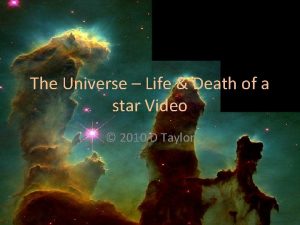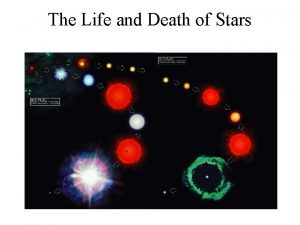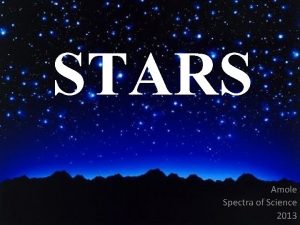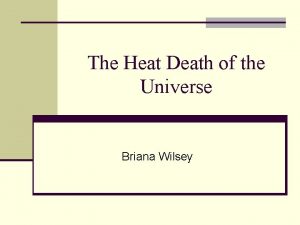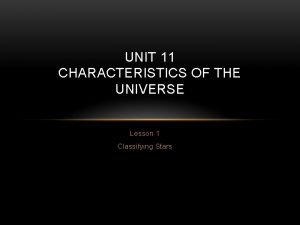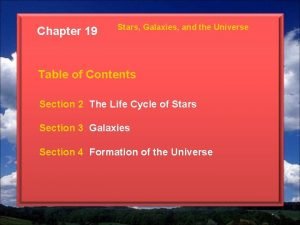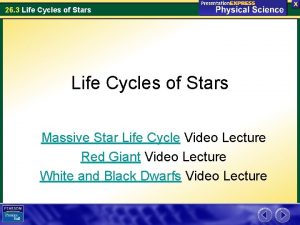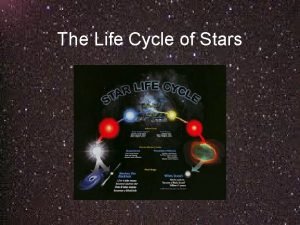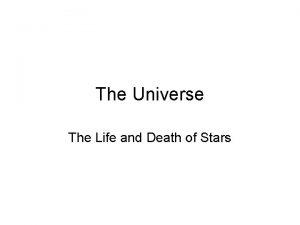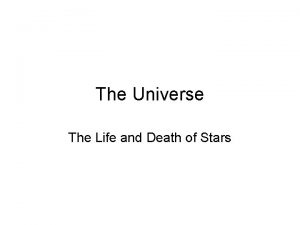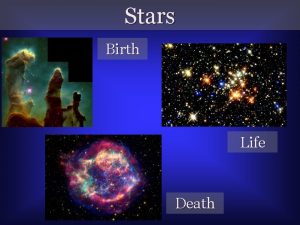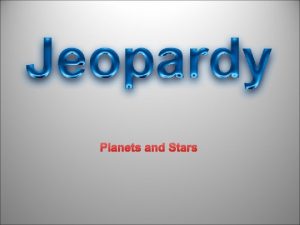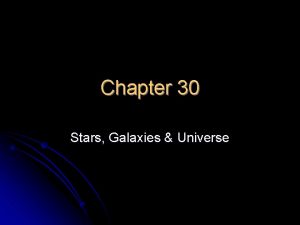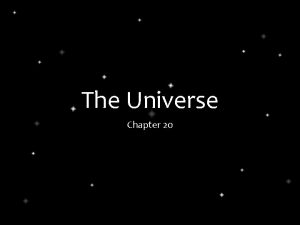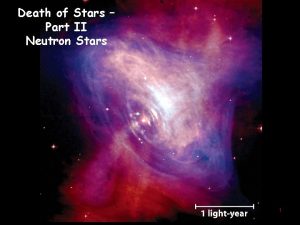The Universe Stars Life and Death of Stars


































































- Slides: 66

The Universe Stars Life and Death of Stars Neutron Stars Black Holes The Steady State theory The Big Bang Theory Our Expanding Universe

Stars • Astronomy is the study of stars (astra means stars, onomy means study of) • Not all stars are like our sun, they can differ in age, size, appearance and they can change over time. • Each galaxy has about 100 billion stars • There are billions of galaxies


The order of planets in our solar system How do you remember?


Pluto • Why is Pluto no longer classified as a planet? • In August 2006 the International Astronomical Union (IAU) downgraded the status of Pluto to that of "dwarf planet. " So now we have 8 planets instead of 9!

• Astronomers refer to the brightness of a star as its magnitude. • The colour of a star is due to its temperature.

Brightness • A star's apparent magnitude a measure of the brightness of a star as it appears to an observer on Earth. • The brighter the object appears, the lower the assigned value of its magnitude

Apparent Magnitude

The distance between stars • We can measure distances to stars by two methods • One method – parallax is only good for the very nearest stars • The other method – comparison of magnitudes is more complex, but it can be used for even the farthest stars and galaxies

Units in space • 1 astronomical unit (denoted AU) is the mean average distance from the Earth to the Sun. This is approximately 150 x 109 m • Astronomers often measure interstellar distances in light years (l. y. ) • 1 Light year = how far light travels in 1 year • (9. 5 trillion kilometres) • Another commonly used unit is the parsec (pc) 1 pc = 3. 26 l. y.

1. Betelgeuse is 650 l. y. away. How many parcecs is this? 2. Bellatrix is 75 pc away, how many light years is this? 3. The Sun is at a distance of 8. 5 kiloparsecs from the centre of the Milky Way system. How many light years is this?

Parsec • The parsec is based on a phenomenon known as parallax. Parallax can be used to measure the distance between the Sun and other stars. • One parsec =

Parallax activity • The basic idea behind parallax and using it to calculate can be illustrated using a moustache. INSTRUCTIONS 1. Hold the moustache in front of your face about 15 cm from your nose and look at it with one eye and then quickly swap to the other eye. The moustache will appear to move with respect to the face – that's the parallax effect. 2. Do the same thing with your moustache held at arm's length. What do you notice?

Parallax activity • Describe what happened. Was the effect for more distant objects greater or smaller than for closer objects? • Explain why you think this happened. Use a diagram to help you

Parallax activity • If you did not know the distance to the moustache but you knew the distance between your two eyes, you could get the distance to the moustache by measuring how much of an angle by which the moustache shifted (get a protractor) and crank out some trigonometry to find the distance.



• http: //www. solarsystemscope. com/scope. swf Things to play with: Orbits of planets, relative to the Earth Distance of planets to sun (AU) Distance of planets to each other (pc)

1. Acrux is 321 l. y. away. How many parsecs? 2. Rigil Kentaurus is 31. 85 pc away. How many l. y. ? 3. Can we see all these stars in the Southern Cross with our naked eye? 4. Which star is the brightest?

Stars The absolute magnitude of a star, M is the magnitude the star would have if it was placed at a distance of 10 parsecs from Earth. By considering stars at a fixed distance, astronomers can compare the real (intrinsic) brightness of different stars.

Absolute magnitude Consider: • Betelgeuse (almost 200 pc from Earth) absolute magnitude -5. 14 • Bellatrix (75 pc from Earth) absolute magnitude -2. 72 Which star produces more light?

Apparent and Absolute Magnitude

Key Ideas: BRIGHTNESS • • Explain the term apparent magnitude Discuss the distance between the stars Convert light years to parsecs Discuss absolute magnitude QUESTION: Contrast the terms absolute magnitude and apparent magnitude

Electromagnetic Spectrum 400 nm The visible region 700 nm

Electromagnetic Spectrum Each star emits light at a range of different wavelengths. Some is in the visible part of the electromagnetic spectrum and some is in the invisible infrared or ultraviolet range.

Star Colour • A star’s spectrum is mainly determined by its surface temperature. Cooler stars (less than 3000°C) have a red-ish appearance. Hot stars (over 30, 000°C) have a blue-ish glow.

Star Colour • Scientists also analyse the light from a star using a spectrometer which splits the light into a spectrum to reveal its component colours. • Chemical elements present in a star can be determined from distinctive lines that appear in its spectrum. • Particular elements emit colours of a particular wavelength.


The Sun • The Sun has dark lines in its spectra called Fraunhofer Lines. These occur from electrons in the atoms in the outer gas layer of the star absorbing light energy at exactly the same wavelength that the same element would emit when extremely hot.

The spectrum of the Sun, showing dark vertical lines called Fraunhofer lines.

Practical – using a spectrometer pg 228 Purpose To compare the spectrum of light produced by different sources and sketch results in a table in your workbook. Method Use a spectrometer to study the spectrum of light from a light globe. Sketch the spectrum in your work book. Answer discussion question: 1. Identify the differences in the spectrum observed for all the different light sources

From the spectra, scientists have created a classification system called spectral class a classification system for stars based on their colour Spectral class indicates the elements present in the star, the temperature and colour of a star.

Spectral Classes of Stars Hottest Coolest

Key Ideas: COLOUR • Describe the Electromagnetic Spectrum • Explain the significance of Fraunhofner Lines

Nuclear Fusion The source of energy that keeps the stars at such high temperatures is a process known as nuclear fusion. Hydrogen’s proton and electron don’t stay bound together in such high temperatures and this state of matter is called plasma.

Nuclear Fusion Two protons are brought together due to massive gravitational forces and fuse together to form a new nucleus. One proton is changed into a neutron and two small particles released: 1 H + 1 H → 2 H + positron + neutrino positron: small positively charged particle – antimatter to electron neutrino: tiny, neutral particle

Nuclear Fusion A positron collides with an electron and annihilate each other to become a high energy gamma ray. As gamma rays make their way out from core of star, their wavelength increases and they turn into the heat, light and UV radiation we see from earth.

Nuclear Fusion The overall result of all these reactions is that hydrogen is converted into helium and energy

They Might Be Giants - Why Does the Sun Shine

Key Ideas: BRIGHTNESS • • Explain the term apparent magnitude Discuss the distance between the stars Convert light years to parsecs Discuss absolute magnitude

Hertzsprung – Russell Diagram The H-R diagram shows a relationship between the brightness and temperature of a star.

Hetrzsprung – Russell Diagram • When absolute magnitude (brightness) was placed on one axis and spectral class (colour) on the other, they noticed that the stars fell into a number of clearly defined groups. • H-R diagrams were also interpreted as showing that stars were changing from one 'type' to another. These changes became known as the 'life cycle' of a star. • https: //m. youtube. com/watch? v=PM 9 CQDl. QI 0 A

Hertzsprung – Russell Diagram On an H-R diagram, most stars fall on a broad line running from the top left-hand corner to the bottom right-hand corner of the H-R diagram. This line is known as the main sequence In a main sequence star, gravity and radiation pressure are in equilibrium, they balance each other out, giving the star a constant radius and brightness. This equilibrium can last for millions or even billions of years until the hydrogen in the core of the starts to run out.

Life cycle of a star • Stars top left: hotter, brighter, bigger, heavier • Stars bottom right: cooler, dimmer, smaller, • Typical stars on main sequence start their lives bottom right and move toward top left

The Origin of Stars • Nebula: A large cloud of gas (helium and hydrogen) and dust which forms into a star. Dust and gas particles exert a gravitational force on each other which keeps pulling them closer together. Orion Nebula

The Origin of Stars • As the particles pull closer together the temperature increases. • At 10, 000 o. C fusion takes place and energy radiates outward through the condensing ball of gas. Another view of the Orion Nebula

The Origin of Stars • Fusion uses up a star’s hydrogen supply rapidly casing the core to heat up and the outer temperature to fall. The star expands and becomes a red giant. Red Giant


Red Giants • When hydrogen in core of medium size star runs out, fusion stops, outward radiation stops and gravity causes star to collapse inward forming a dense core and a large, cooler outer atmosphere. • As more matter added to the core, helium fuses into heavier elements such as carbon.

Nuclear Fusion can create heavier atoms

Planetary nebula Around 100 million years later, the helium fuel in the red giant’s core runs out and outer layers escape to become a gas cloud known as a planetary nebula. Half the mass of the star is lost to this planetary nebular. The remaining core is hot and emits UV light.

White dwarf Over time, the planetary nebula disperses and the hot, dense core fades to become a very dense star called a white dwarf. The lower brightness now drops to the bottom of the H-R diagram and off the main sequence. Nuclear fusion ceases in a white dwarf and the star fades to become a cold, dark ball of inert matter called a black dwarf.

Density is mass per unit volume Q 9 Unit Review pg 226 Density = mass volume Example: Earth has mass of 6. 0 x 1024 kg and a volume of 1. 1 x 1021 m 3 Calculate its average density

Super giants • Stars 10 x more massive then our sun have a different life cycle and start as massive stars called super giants. Higher gravitational forces mean they burn their hydrogen fuel quicker. Super giants cool down but their brightness stays the same – they shift L to R on the H-R diagram.

Supernova When no more material is left in the core, the other layers collapse at such high speed that the material rebounds in a massive explosion called a supernova, shining over 100 million times brighter then before! Neutron Star


Neutron stars If the amount of material left by a supernova is 1. 4 -3 times the mass of our sun, gravitational forces can break down the structure of the atoms and result in a neutron star. Neutron stars have an enormous density as mass is compressed into a sphere about 10 – 15 kms across.

Black Holes If the amount of material left by a supernova is more then 3 times the mass of our sun, the process of collapse does not end with a neutron star but keeps shrinking even further to what scientists refer to as a singularity or a black hole. A black hole is believed to be formed from the death of a neutron star.

Black Holes Black holes are so dense and exert such a strong gravitational pull, that not even light can escape. Black holes distort the space around them, and can often suck neighbouring matter into them - including stars!

Black Holes Two methods to detect black holes: 1. A binary star system: one of the stars becomes a black hole and its huge gravitational field starts to strip material from the other star.


Black Holes 2. Gravitational lensing The gravitational field around a black hole is so strong it can distort the shape of space and light from a distant star passing either side of the black hole can be bent back to Earth so we see identical stars either side of the black hole.

Black Holes - Gravitational lensing

The initial size of a star determines its life cycle and the type of star it will eventually become.

Kahoot https: //kahoot. it
 Life and death of stars
Life and death of stars The life and death of stars
The life and death of stars Types of stars in the universe
Types of stars in the universe ❄️ heat death of the universe
❄️ heat death of the universe There are millions of stars in the space
There are millions of stars in the space What is the answer to life the universe and everything
What is the answer to life the universe and everything Characteristics of sunnatullah
Characteristics of sunnatullah Difference between somatic and molecular death
Difference between somatic and molecular death Life cycle of a low to medium mass star
Life cycle of a low to medium mass star The death drive
The death drive What type of design principle is used in the royal altar
What type of design principle is used in the royal altar In life and death we belong to god
In life and death we belong to god Paul cardall life and death
Paul cardall life and death It is allah who gives life and death
It is allah who gives life and death Dancing skeletons dettwyler
Dancing skeletons dettwyler Natural cycle of life and death
Natural cycle of life and death Words have the power of life and death
Words have the power of life and death What is the life cycle of a star
What is the life cycle of a star What are the stages of a stars life cycle
What are the stages of a stars life cycle Life cycle of stars graphic organizer
Life cycle of stars graphic organizer Chapter 19 section 2 the life cycle of stars answer key
Chapter 19 section 2 the life cycle of stars answer key Section 26.3 life cycles of stars
Section 26.3 life cycles of stars Life cycles of stars
Life cycles of stars Stellar evolution lab the life cycle of a star answer key
Stellar evolution lab the life cycle of a star answer key Hình ảnh bộ gõ cơ thể búng tay
Hình ảnh bộ gõ cơ thể búng tay Frameset trong html5
Frameset trong html5 Bổ thể
Bổ thể Tỉ lệ cơ thể trẻ em
Tỉ lệ cơ thể trẻ em Voi kéo gỗ như thế nào
Voi kéo gỗ như thế nào Chụp tư thế worms-breton
Chụp tư thế worms-breton Bài hát chúa yêu trần thế alleluia
Bài hát chúa yêu trần thế alleluia Các môn thể thao bắt đầu bằng tiếng chạy
Các môn thể thao bắt đầu bằng tiếng chạy Thế nào là hệ số cao nhất
Thế nào là hệ số cao nhất Các châu lục và đại dương trên thế giới
Các châu lục và đại dương trên thế giới Công thức tính thế năng
Công thức tính thế năng Trời xanh đây là của chúng ta thể thơ
Trời xanh đây là của chúng ta thể thơ Mật thư anh em như thể tay chân
Mật thư anh em như thể tay chân 101012 bằng
101012 bằng Phản ứng thế ankan
Phản ứng thế ankan Các châu lục và đại dương trên thế giới
Các châu lục và đại dương trên thế giới Thơ thất ngôn tứ tuyệt đường luật
Thơ thất ngôn tứ tuyệt đường luật Quá trình desamine hóa có thể tạo ra
Quá trình desamine hóa có thể tạo ra Một số thể thơ truyền thống
Một số thể thơ truyền thống Cái miệng nó xinh thế chỉ nói điều hay thôi
Cái miệng nó xinh thế chỉ nói điều hay thôi Vẽ hình chiếu vuông góc của vật thể sau
Vẽ hình chiếu vuông góc của vật thể sau Nguyên nhân của sự mỏi cơ sinh 8
Nguyên nhân của sự mỏi cơ sinh 8 đặc điểm cơ thể của người tối cổ
đặc điểm cơ thể của người tối cổ Ví dụ giọng cùng tên
Ví dụ giọng cùng tên Vẽ hình chiếu đứng bằng cạnh của vật thể
Vẽ hình chiếu đứng bằng cạnh của vật thể Fecboak
Fecboak Thẻ vin
Thẻ vin đại từ thay thế
đại từ thay thế điện thế nghỉ
điện thế nghỉ Tư thế ngồi viết
Tư thế ngồi viết Diễn thế sinh thái là
Diễn thế sinh thái là Dot
Dot Số.nguyên tố
Số.nguyên tố Tư thế ngồi viết
Tư thế ngồi viết Lời thề hippocrates
Lời thề hippocrates Thiếu nhi thế giới liên hoan
Thiếu nhi thế giới liên hoan ưu thế lai là gì
ưu thế lai là gì Sự nuôi và dạy con của hổ
Sự nuôi và dạy con của hổ Khi nào hổ mẹ dạy hổ con săn mồi
Khi nào hổ mẹ dạy hổ con săn mồi Hệ hô hấp
Hệ hô hấp Từ ngữ thể hiện lòng nhân hậu
Từ ngữ thể hiện lòng nhân hậu Thế nào là mạng điện lắp đặt kiểu nổi
Thế nào là mạng điện lắp đặt kiểu nổi Chapter 30 galaxies and the universe
Chapter 30 galaxies and the universe
